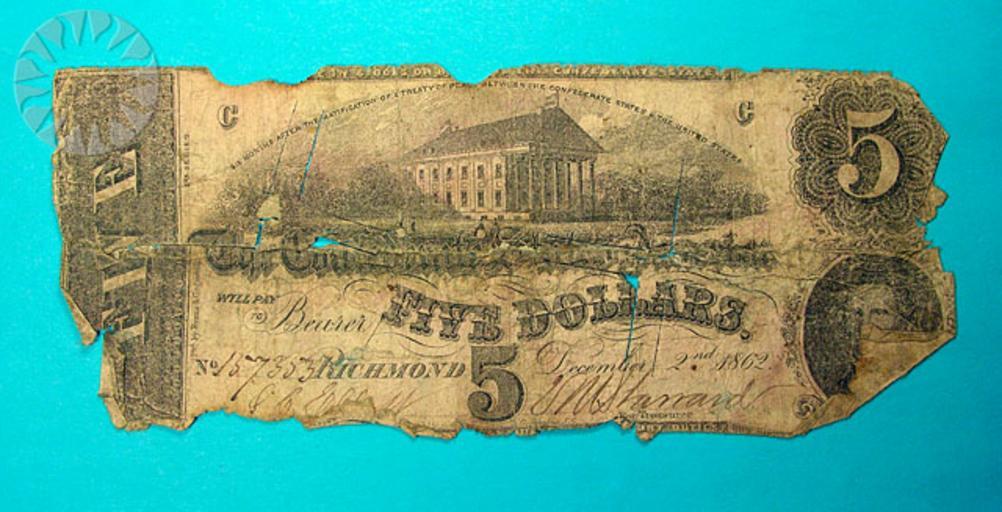MAKE A MEME
View Large Image

| View Original: | Confederacy,_5_Dollars,_1862.jpg (640x327) | |||
| Download: | Original | Medium | Small | Thumb |
| Courtesy of: | www.flickr.com | More Like This | ||
| Keywords: legendary coins legendarycoins numismatics money smithsonian probably public domain probablypublicdomain SI Neg. 2005-27383. Date: 9/1/2005...Like the fledgling United States during the American Revolution, the Confederacy struggled to keep its money in existence during the American Civil War, 1861-1865. Coinage had never been all that plentiful in the states that now made up the Southern Confederacy. It was a debtor area, with coinage flowing out for purchase of manufactured goods about as quickly as it flowed in from the sale of agricultural ones. .And just as during the Revolution, a new nation lacking precious metals must issue paper money to support a war. The Confederacy was even more dependent on paper currency than had been an earlier generation of patriots. During the 85 years between 1776 and 1861, the proportion of people tied to a monetary economy had grown, even in the agricultural South. .There, a bewildering variety of authorities now began to issue currency-the new central government, the Confederate States of America; the individual states; cities and towns; private banks both old and new; and even private citizens..This object tells us something about popular attitudes of the day. As with Continental and state notes in the 1770s, there was an almost superstitious aversion to allowing Confederate notes to fall to pieces. So they would be sewn together, or more frequently glued back together, reinforced with any stray bits of paper deemed fit for the job. This five-dollar bill was reinforced with part of a low-value (ten-cent) note from Mississippi. Specialists call this sort of minor currency "scrip", and it played an essential role on the lower end of the monetary scale during the early and middle phases of the war. .By the way, that's Confederate Treasury Secretary C. G. Memminger peaking out from behind the fold at lower-right..Click here to view the obverse...Credit: Tom Mulvaney (Smithsonian Institution) SI Neg. 2005-27383. Date: 9/1/2005...Like the fledgling United States during the American Revolution, the Confederacy struggled to keep its money in existence during the American Civil War, 1861-1865. Coinage had never been all that plentiful in the states that now made up the Southern Confederacy. It was a debtor area, with coinage flowing out for purchase of manufactured goods about as quickly as it flowed in from the sale of agricultural ones. .And just as during the Revolution, a new nation lacking precious metals must issue paper money to support a war. The Confederacy was even more dependent on paper currency than had been an earlier generation of patriots. During the 85 years between 1776 and 1861, the proportion of people tied to a monetary economy had grown, even in the agricultural South. .There, a bewildering variety of authorities now began to issue currency-the new central government, the Confederate States of America; the individual states; cities and towns; private banks both old and new; and even private citizens..This object tells us something about popular attitudes of the day. As with Continental and state notes in the 1770s, there was an almost superstitious aversion to allowing Confederate notes to fall to pieces. So they would be sewn together, or more frequently glued back together, reinforced with any stray bits of paper deemed fit for the job. This five-dollar bill was reinforced with part of a low-value (ten-cent) note from Mississippi. Specialists call this sort of minor currency "scrip", and it played an essential role on the lower end of the monetary scale during the early and middle phases of the war. .By the way, that's Confederate Treasury Secretary C. G. Memminger peaking out from behind the fold at lower-right..Click here to view the obverse...Credit: Tom Mulvaney (Smithsonian Institution) | ||||